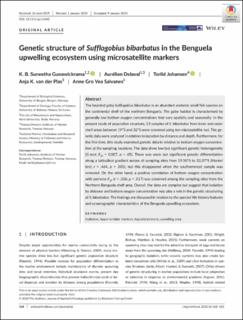Genetic structure of Sufflogobius bibarbatus in the Benguela upwelling ecosystem using microsatellite markers
Gunawickrama, Kristogu Baduge Suneetha; Delaval, Aurelien Nicolas; Johansen, Torild; van der Plas, Anja; Salvanes, Anne Gro Vea
Peer reviewed, Journal article
Published version
Permanent lenke
https://hdl.handle.net/11250/2669163Utgivelsesdato
2020Metadata
Vis full innførselSamlinger
Originalversjon
Gunawickrama, K. B. S., Delaval, A. N., Johansen, T., van der Plas, A. & Salvanes, A. G. V. (2020). Genetic structure of Sufflogobius bibarbatus in the Benguela upwelling ecosystem using microsatellite markers. Journal of Applied Ichthyology, 36(2), 168-182. doi: 10.1111/jai.14002Sammendrag
The bearded goby Sufflogobius bibarbatus is an abundant endemic small fish species on the continental shelf of the northern Benguela. The goby habitat is characterised by generally low bottom oxygen concentrations that vary spatially and seasonally. In the present study of population structure, 13 samples of S. bibarbatus from inner and outer shelf areas between 19°S and 32°S were screened using ten microsatellite loci. The genetic data were analysed in relation to isolation by distance and depth. Furthermore, for the first time, this study examined genetic data in relation to bottom oxygen concentration at the sampling locations. The data show low but significant genetic heterogeneity (G‐test; FST = 0.007, p < .05). There was weak but significant genetic differentiation along a latitudinal gradient across all sampling sites from 19.50°S to 32.37°S (Mantel test; r = .464, p = .001), but this disappeared when the southernmost sample was removed. On the other hand, a positive correlation of bottom oxygen concentration with pairwise FST (r = .336; p = .017) was observed among the sampling sites from the Northern Benguela shelf area. Overall, the data are complex but suggest that isolation by distance and bottom oxygen concentration may play a role in the genetic structuring of S. bibarbatus. The findings are discussed in relation to the species’ life history features and oceanographic characteristics of the Benguela upwelling ecosystem.

